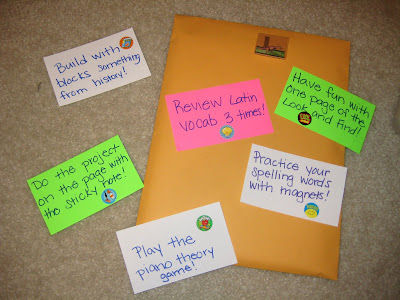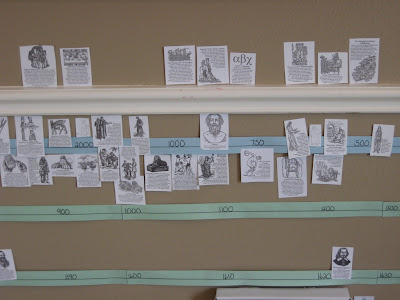


Hello!
How do we use workboxes in our school? (If you have no idea what I'm talking about, see my post over on There's No Place Like Home)
Before we get into the how - let's get into the why. A few weeks ago John made the comment that school wasn't that fun anymore. As I thought about it, I realized the child was right. We hadn't really been having all that much fun. It had been taking all my time and effort to get through the necessaries and unfortunately some of the spunky fun was getting left behind. I thought, researched, and thought some more. And I was led to the workbox system. It was just what we needed to put some of what the kids think is just plain fun (and sneaky Mom knows that it's really educational fun) back into our school day.
Now, on to the how. The kids work through their workboxes while I am tutoring their sibling. So while I am tutoring Madi in math, John is busy with his workboxes. By the time the end of our school day rolls around, the kids each have a folder or two left which enables me to get things recorded and wrapped up in the classroom. I have even found time to, you are not going to believe this, do some of my own studying. Can you believe it? I'm having a hard time believing it myself, but it is true.
What do we fill our folders with? I'll list for you what we have filled our folders with the last three days.
John Day #1
#1- Usborne art project
#2 - Journal
#3- Spelling
#4- Puzzle of 50 states
#5- Latin
#6 - Vocab
#7- Piano Theory Game (15 min on computer)
#8 - Handwriting
#9 - Read chp. of Farmer Boy
#10 - Recitation
#11 - Free Read (20 min)
#12 - Build something from history with blocks (He built a fine looking Trojan Horse)
Madi Day #1
#1- Sort the Seasons activity
#2 - Journal
#3 - Spelling
#4 - Write spelling words with magnets
#5 - Handwriting
#6 - Recitation
#7 - Read two books to dolls (she actually squealed with delight when she opened this one)
#8 - Dot to Dot
#9 - Piano Theory Game
#10 - Pattern Block Design
#11 - File Folder Game
#12 - Build with Lincoln Logs
John Day #2
#1 - Review Latin Vocab 3 times
#2 - One page from Look and Find
#3 - Vocab
#4 - Usborne Art Project
#5 - Read chp. of Farmer Boy
#6 - Handwriting
#7 - Journal
#8 - Crossword Puzzle
#9 - Recitation
#10 - Free Read (20 minutes)
#11 - Spooky Mansion computer game (15 min)
#12 - Graphing counters
Madi Day #2
#1 - Handwriting
#2 - Usborne Art Project
#3 - Puzzle
#4 - Recitation
#5 - Spooky Mansion (15 min)
#6 - Read to dolls
#7 - Worksheet on antonyms
#8 - Journal
#9 - Look and Find
#10 - Tell glove puppet story to dolls
#11 - Educational DVD
#12 - Work on stitching sampler
John Day #3
#1- Read designated book and make list of main characters
#2 - Spelling
#3 - Read designated book and look up corresponding website
#4 - Read chp. of Farmer Boy
#5 - Listen to story on CD
#6 - Recitation
#7 - Vocab
#8 - Art Project
#9 - Journal
#10 - Work on Cub Scout requirement
#11 - Free Read (20 minutes)
#12 - Free Time!
Madi Day #3
#1 - Listen to story on CD
#2 - Spelling
#3 - Read to dolls
#4 - Paint from history
#5 - Recitation
#6 - Read designated book and identify setting
#7 - Graph teddy bear counters
#8 - Journal
#9 - 15 min on designated website
#10 - Sampler
#11 - Dot to Dot
#12 - Free Time!
The kids really like knowing that there will be a few fun things mixed in during the day. They also enjoy the suspense of not knowing exactly when these fun things will happen.
This probably sounds like a lot of work. It really isn't. It just takes a few minutes at the end of the day to assemble the following day's workboxes. I am surprised that in the same amount of time it was taking us to complete all of our school work, we are now accomplishing so much more.
But do you know what the best part is? The smiles on the faces of my children reflecting their excitement at starting a new day of school.










